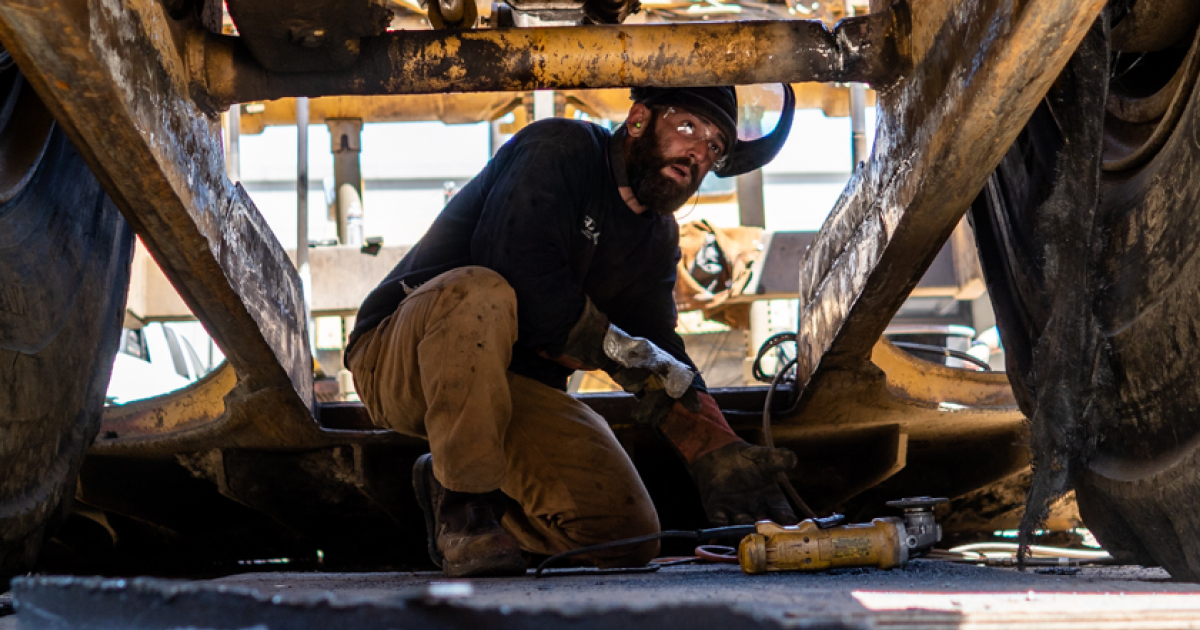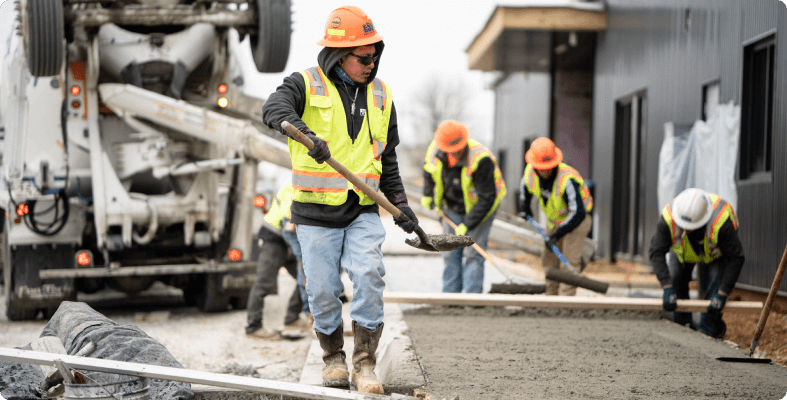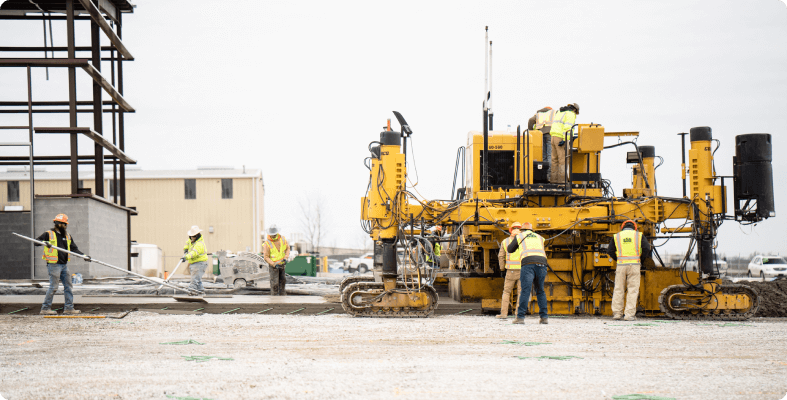What You Need to Know About Mental Health in the Dirt World
Written by Megan Hamilton • Reviewed by Laura Meyer
September 7, 2022

Mental health awareness is gaining traction in our culture right now, but we don't often talk about it in the Dirt World.
Maybe you want information on mental health in construction, and you haven’t found much. Maybe you’re thinking, This is good to know, but my crew is okay.
Are you sure about that? Do you know they’re okay?
Even if you believe your employees are well, the statistics say otherwise. We’ll uncover the truth about mental health in the Dirt World and why so many workers in this industry struggle. We’ll also give you some tips on how to help your crew members.
The state of mental health in the Dirt World

Nobody talked about mental health in the Dirt World for a long time. No one asked crew members, “Are you depressed, anxious, or stressed about money? Is your marriage struggling? Are you drinking alone? Do you sometimes wish you were dead?”
That may sound dramatic. However, construction workers and miners are at the highest risk of suicide when you compare them to employees in any other industry. They’re one-and-a-half times more likely to take their own lives.1 That’s not just sad—it’s devastating for the workers, their families, and the Dirt World.
Now, researchers are polling crews to learn more about how they’re doing. And people who have worked in the industry, like BuildWitt CEO Aaron Witt, are opening up about their own mental health journeys.
When we take the time to listen and learn about mental health in the Dirt World, we can help workers improve their well-being. With that said, let’s take a look at what’s happening.
Mental health and suicide in the U.S.
Before we look at the Dirt World specifically, we need to see the bigger picture of mental health and suicide in the U.S.
Around 40 million American adults deal with anxiety yearly, and 21 million have major depression.2,3 (That excludes kids and people with mild or moderate depression, so the numbers are higher.) Additionally, 40% of Americans said their mental health suffered negative effects due to the coronavirus pandemic.4
In 2020, nearly 46,000 Americans died by suicide—and 1.2 million more attempted it.5 Overall, suicide was the 10th leading cause of death for Americans of all age groups in 2018. (It ranked second for ages 15-34 and fourth for ages 35-54.)6
So regardless of who you are or what you do, mental health and wellness concern all of us. That’s especially true in the Dirt World, where people are at even higher risk.
Mental health and suicide in the Dirt World
“Unintentional injury” is a likelier cause of death than suicide for every age group.7 Yet over four times as many construction workers died by suicide in 2016 than from workplace injuries.8,9
That year, the CDC conducted a study to learn whether people who worked in certain industries were at greater risk for suicide. They found that the construction industry had the highest suicide rate. Mining, quarrying, and extraction were close behind:
| Construction | Mining, extraction, and quarrying | All industries | |
| Suicide rate (per 100,000) | 54.7 | 54.2 | 35.110 |
| Number of employees in the industry | 6.8 million11 | 616,80012 | 45 million |
| Total deaths by suicide | 3,702 | 334 | 15,77913 |
Of the total suicides in all industries, 26% happened in the Dirt World.14 This isn’t a new problem, either. An older CDC study shows that the suicide rate in construction and extraction increased from 44 per 100,000 workers in 2012 to 53 in 2015.15
We’re still waiting on more recent data to come out. But based on those trends and the national increase in mental health struggles over the past few years, the suicide rate in the Dirt World has likely continued rising.
How mental health awareness affects you and your team members
As a good, caring leader, you want to help your employees be well and enjoy life. You want to engage in mental health awareness and suicide prevention. You’d also like to think that if one of your crew members was struggling with these issues, they’d come talk to you about it.
Yet often when someone takes their life, their employer, colleagues, and even loved ones are often shocked. There are almost always crew members who get the news and say, “Bill? There’s no way. He was the funniest guy I knew!”
The truth is, none of us truly know someone is (or isn’t) okay unless we’ve created a caring culture where people feel safe opening up. The first step is learning why Dirt World workers are at higher risk for mental health struggles. Once we understand the risks, we can take steps to mitigate them.
Why are workers in the Dirt World at higher risk for mental health issues?

Before we move forward, we want to be very clear: the Dirt World isn’t to blame for the mental health of its workers. This isn’t the industry’s fault. It isn’t a case where “construction made me do it” or “mining made me do it.”
And mental health struggles definitely aren’t because leaders don’t care about their people. In a recent survey, 94% of construction leaders said it’s important to share mental health resources at work.16
However, leaders may not fully realize how mental health issues are affecting their team. And while those issues aren’t the leader’s or the industry’s fault, some situations in the Dirt World can unwittingly increase risk factors for workers.
Let’s explore those reasons, so you can start taking steps to best help your team raise their mental health awareness and prevent suicide.
Personal risk factors
Culturally, the Dirt World attracts ambitious, hardworking, adventurous people. They’re willing to bust their backs to better themselves and their families.
“The people who are drawn to this industry are kind of more naturally at risk . . . It’s the risk-seeking behavior, the independent spirit this work attracts. Strength, determination, grit, perseverance—all these things that we love about the industry and the people in this industry—can also make you more at risk for untreated mental health [issues] and suicide,” says Michelle Walker, Founding Chairman of the Construction Industry Alliance for Suicide Prevention (CIASP).
The Dirt World is also a male-dominated industry. Men are more likely to commit suicide than women; 79% of American workers who died by suicide in 2016 were men.17 So right away, you’re working with a higher-risk population.
Perceptions of the industry
It’s common for people to see construction and extraction workers as rough-and-tough personas. And those workers wear that image like a badge of honor. However, that can lead them to stay silent about their mental health.
Workers who can’t just “suck it up” or “tough it out” feel ashamed for not being as strong as they think they should be. They’re afraid to be vulnerable with their coworkers and supervisors because they feel like they’ll be judged or—worse—face consequences like losing their jobs.
Many, especially old school workers who have been around a long time, think it’s inappropriate to talk about personal problems or mental health at work. They also don’t see others seeking help, so they may not know they can approach you or how to begin that conversation.
According to Michelle, the best way to help workers open up is “by encouraging more positive communication and healthy conflict resolution, having zero tolerance for harassing behaviors . . . [and] creating strong teams.”
Long hours and tough schedules
Working in the Dirt World can come with crazy schedules and long hours. That contributes to a lack of sleep, which is a huge factor in mental health.
People who sleep less than six hours a night are more than twice as likely to have mental health issues than people who sleep longer.18 Chronic lack of sleep can lead to:
- Anxiety
- Obesity
- Diabetes
- Depression
- Lack of focus
- Memory loss
- Heart disease
- Low self-esteem
- Substance abuse
- High blood pressure
- Suicidal ideation and suicide attempts19
Shift work and long hours are two leading causes of sleep loss—and in turn, mental health issues.20 Shift workers are four-and-a-half times more likely to struggle with depression and four times more likely to struggle with anxiety than non-shift workers.21 People who start shifts at weird times, work long hours, or work on Sundays are also more likely to get injured on the job.22
Traveling for work
Traveling for work takes crew members away from home for long periods. They can’t interact normally with their spouses, kids, friends, or community groups like volunteer organizations, clubs, support groups, or churches.
“This can take at-risk individuals away from their support systems at home and create unhealthy behaviors like substance misuse to deal with loneliness and isolation,” Michelle explains.
To rub salt in the wound, construction workers are now seeing more people work jobs with flexible schedules, unlimited paid time off, remote work, and—therefore—more family time.
According to researcher Marija Avota, “Shift workers [believe] that support from their family, friends, romantic partners, and a healthy lifestyle are the best strategies to improve their well-being.”23
Now, you can’t just change the project location or schedule. But you can get to know your employees. If you’ve got a new mom or dad on your crew, give them some preference when you make the schedule. If someone’s taking care of a sick spouse or parent, give them some flexibility.
Michelle says, “This not only makes the industry more inviting but also protects workers from the stress of family needs not being met.” It also shows workers you care, making them more willing to open up and partner with you to find better work-life balance.
Job stress and job insecurity
Job stress, job insecurity, and low pay are three of the biggest work-related reasons people commit suicide.24 Let’s take a look at job stress and insecurity first.
First of all, working in the Dirt World is amazing, but it can also be insanely stressful. There’s always the risk of injury, and heavy equipment beats up people’s bodies (more about that in a minute). Throw in a supervisor who berates his crew or unhealthy company culture, and you’ve got a recipe for disaster.
Job stress can have immediate effects like headaches and inability to focus, and it causes long-term effects like anxiety, depression, and bad habits like smoking, drinking too much coffee, or skipping exercise.25
The only thing more stressful than working a job like that is the fear of losing it altogether. Nearly one in five manual laborers are afraid they’ll lose their job within the next year.26 That creates a sense of instability and leaves them asking, “Will I be able to get another job? What if no one hires me? How will I provide for my family?”
Losing a job—or fear of losing it—can lead to a sense of hopelessness, failure, and depression. As a leader, your ability to grow your company can help create greater job security for your team.
And the key to relieving work stress? Science says it’s good social support from family, friends, romantic partners, colleagues, and workplace leaders.27 When people know you truly care about how they’re doing, they experience less stress and better mental well-being.
Financial and marital stress
Money can’t buy happiness—but stressing about money can make your crew members unhappy. Ultimately, it leads to mental health and relationship problems.
Even if you pay your workers extremely well, they may still struggle with money. Almost 60% of Americans have struggled to pay basic bills, and 44% have struggled to afford food in the past three months.28
Workers are under a ton of pressure to provide financially, and it can cause major tension at home. Married couples fight harder and longer about money than anything else—and those arguments are the second leading cause of divorce, right after cheating.29,30
Divorce increases stress creates new financial problems, and can harm the whole family’s physical and mental health issues. Studies show that most divorced adults are more likely to have insomnia, immune problems, heart attacks, and depression than married adults. They’re even more likely to die young.31
Divorce creates additional stress for parents as they worry about their kids—who may be more likely to perform poorly in school, develop mental health issues, and even become victims of abuse.32
The crew members who perform best at work have peace in their homes. They’re able to come to work and fully focus on the job. You can help your crew members achieve that by adding employee benefits like financial wellness programs, marriage resources, and counseling resources. (If insurance doesn’t cover counseling, you may consider offering counseling assistance to help your workers offset the cost.)
Physical safety and injuries
Jobsite safety issues plague many companies. In 2020, construction companies reported that 165,300 workers got hurt. (That’s not counting the injuries that went unreported.) Another 1,008 construction workers died in workplace accidents.33
Safety protocol in the Dirt World has come so far, and you can reduce safety risks in many ways—especially with engaging, effective training. However, working with big iron and big dirt is inherently dangerous. A freak accident or simple mistake can easily get someone hurt.
That risk goes up when workers are chronically stressed. The stress hormone cortisol damages their bodies—making them more likely to get sick, have stomach issues, and develop depression and anxiety.34 Anxiety makes people clumsier because they’re distracted, hesitant, or have sweaty or shaky hands.35 That all increases the chance of accidents.
Michelle Walker adds, “Even when injury incidents don’t occur, the physical nature of construction work can result in wear and tear on the body.” Workers who struggle with chronic pain and physical limitations often begin feeling hopeless.
“[They have] feelings of ‘I will always be in pain’ or ‘I can’t physically do the work to make a living,’” Michelle explains. That can lead to drug, alcohol, or prescription medication addictions—as well as depression and increased risk of suicide.36
Leaders must promote safety programs and be diligent about keeping their workers as safe as possible. That could look like safety training, return-to-work programs, trauma counseling after a workplace accident, and physical wellness programs.
Improving mental health in construction

The Dirt World is an amazing industry. “We have to recognize these things that we respect the heck out of and that we love,” Michelle says. Along with that, we must be aware that some of those things can also contribute to mental health issues.
One of the driving traits of the Dirt World is that the industry and its people are resilient. But resiliency is not sucking it up and pushing through. Resiliency is a skill that we can learn and teach people. It’s how we take care of ourselves, build others up, and help them overcome challenges.
Takeaways:
- Know your employees and what puts them at risk of mental health issues.
- Stay informed about who needs the most flexibility for schedules and travel, and do your best to accommodate those needs.
- Give your employees plenty of time off to rest and recharge.
- Train your foremen on good leadership skills.
- Create a caring, supportive culture where people feel safe opening up.
- Take the steps to grow and stabilize your business so you can offer more security.
- Offer wellness benefits like financial education, counseling, and marriage resources.
- Provide safety training and return-to-work programs.
- Educate yourself on how to prevent suicide in the construction industry.














